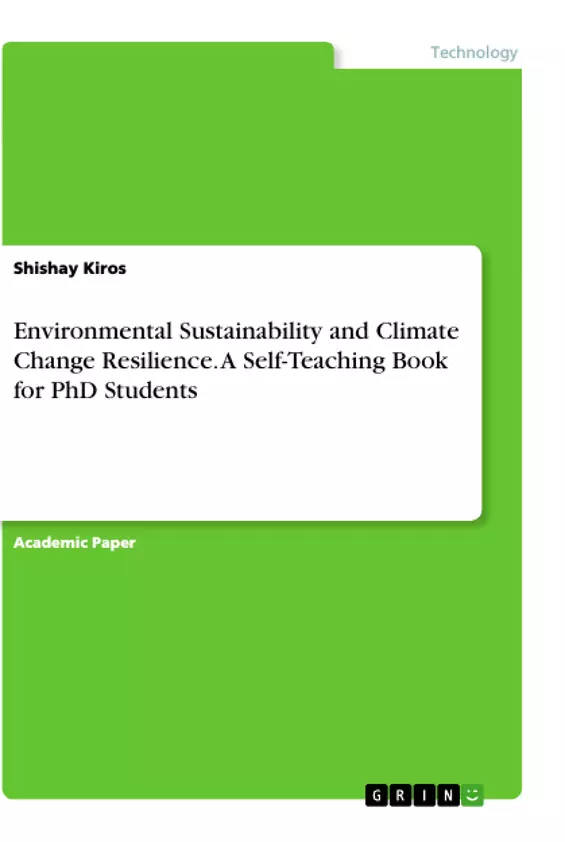This book is meant to be an introductory text on the fundamentals of environment, climate change and resilience management and used as teaching material for Ph.D. students. Today, knowledge of environment is essential for students as well as practicing scientists of all disciplines. Here, an attempt has been made to provide precise and up-to-date information on the fundamental aspects of environment without going much in-depth in to specific areas, so as to be useful for a cross section of fields of study. This book covers all domains of this field, including the policy aspects and management practices.
The book adopts a simple narrative style keeping in mind both the knowledge requirements and the examination needs of university students. This self-teaching text book provides a comprehensive coverage of the key scientific, technical, social and political aspects of environment and climate change in an easily referenced and reader-friendly style. This text book can be used as self-teaching material for the Ph.D. students but in addition to this the author would recommend this text book to students new to the field that wish to expand their knowledge.
Inhaltsverzeichnis (Table of Contents)
- Preface
- Basic Terms
- Absorption
- Acid rain
- Air quality
- Asbestos
- Biodegradable material
- Carbon dioxide (CO2)
- Carcinogenic
- Catchment
- Desertification
- Ecological footprint
- Effluent
- Mutagenic
- Energy recovery
- Environmental burden (EB)
- Environmental damage - monetary valuation
- Incineration
- Indoor air quality
- Anthropogenic(chiefly of pollution)
- Nonpoint Source
- Downstream environmental impacts
- Zero Waste approach
- particulate matter /particle pollution
- Glossary
- Abbreviations
- CDM
- GEF
- LDCF
- NAPA
- SCCF
- UNFCCC
- WRI
- IPCC
- GHG
- LULUS
- RBT
- SPM
- IR
- IAP
- ISWRMP
- ERF
- CRD
- IEMS
- EMAS
Zielsetzung und Themenschwerpunkte (Objectives and Key Themes)
This book serves as an introductory text for Ph.D. students, providing a comprehensive understanding of the fundamental principles of environment, climate change, and resilience management. The text aims to deliver precise and up-to-date information on the core aspects of the environment, covering scientific, technical, social, and political dimensions. It adopts a clear and simple narrative style, catering to the knowledge requirements and examination needs of university students.
- Fundamental principles of environment and climate change
- Resilience management strategies
- Scientific, technical, social, and political aspects of environmental sustainability
- Policy aspects and management practices
- Key terms and concepts related to environmental sustainability and climate change
Zusammenfassung der Kapitel (Chapter Summaries)
- Preface: Introduces the purpose and scope of the book as a self-teaching resource for Ph.D. students in environmental sustainability and climate change resilience. It highlights the importance of environmental knowledge for all disciplines and aims to provide a comprehensive coverage of key aspects in an accessible manner.
- Basic Terms: Provides definitions and explanations for a range of terms and concepts relevant to environmental sustainability and climate change. This section serves as a glossary for readers to understand the key vocabulary used throughout the book.
- Glossary: Presents a detailed list of terms and their corresponding definitions, expanding on the brief descriptions provided in the previous section. This comprehensive glossary serves as a valuable reference point for understanding key concepts and terminology within the field of environmental sustainability and climate change.
Schlüsselwörter (Keywords)
This self-teaching text book focuses on key concepts such as environmental sustainability, climate change, resilience management, pollution, waste management, environmental burden, energy recovery, and indoor air quality. It explores the interconnectedness of these themes, emphasizing the importance of understanding their complex interplay for tackling environmental challenges and promoting sustainable development.
- Arbeit zitieren
- Shishay Kiros (Autor:in), 2020, Environmental Sustainability and Climate Change Resilience. A Self-Teaching Book for PhD Students, München, GRIN Verlag, https://www.grin.com/document/1040018



